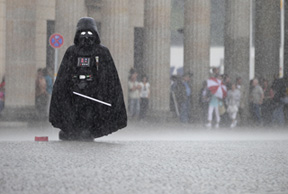
It was late on a school night, so Jennifer’s kids were already asleep when she got a phone call from a friend of her 15-year-old daughter, Jasmine. “Jasmine is on a Web page and she’s naked.” Jennifer woke Jasmine, and throughout the night, the two of them kept getting texts from Jasmine’s friends with screenshots of the Instagram account. It looked like a porn site—shot after shot of naked girls—only these were real teens, not grown women in pigtails. Jennifer recognized some of them from Jasmine’s high school. And there, in the first row, was her daughter, “just standing there, with her arms down by her sides,” Jennifer told me. “There were all these girls with their butts cocked, making pouty lips, pushing their boobs up, doing porny shots, and you’re thinking, Where did they pick this up? And then there was Jasmine in a fuzzy picture looking awkward.” (The names of all the kids and parents in this story have been changed to protect their privacy.) You couldn’t easily identify her, because the picture was pretty dark, but the connection had been made anyway. “OMG no f‑ing way that’s Jasmine,” someone had commented under her picture. “Down lo ho,” someone else answered, meaning one who flies under the radar, because Jasmine was a straight‑A student who played sports and worked and volunteered and was generally a “goody-goody two shoes,” her mom said. She had long, silky hair and doe eyes and a sweet face that seemed destined for a Girl Scouts pamphlet, not an Instagram account where girls were called out as hos or thots (thot stands for “that ho over there”).
That night, in March of this year, Jennifer tried to report the account to Instagram’s privacy-and-safety center, hoping it would get taken down. She asked several friends to fill out the “report violations” page too, but after a few hours, the account was still up. (Instagram’s help center recommends contacting local authorities in cases of serious abuse.) She considered calling 911, but this didn’t seem like that kind of emergency. So she waited until first thing the next morning and called a local deputy sheriff who serves as the school resource officer, and he passed the message on to his superior, Major Donald Lowe. Over the years, Lowe had gotten calls from irate parents whose daughters’ naked pictures had popped up on cellphones, usually sent around by an angry boyfriend after a breakup. But he immediately realized that this was a problem of a different order. Investigation into the Instagram account quickly revealed two other, similar accounts with slightly different names. Between them, the accounts included about 100 pictures, many of girls from the local high school, Louisa County High, in central Virginia. Some shots he later described to me as merely “inappropriate,” meaning girls “scantily clad in a bra and panties, maybe in a suggestive pose.” But some “really got us”—high-school girls masturbating, and then one picture showing a girl having sex with three boys at once.
Lowe has lived in Louisa County, or pretty close to it, for most of his life. The county is spread out and rural, but it is by no means small-town innocent. People there deal drugs and get caught up with gangs, and plenty of high-school girls end up pregnant. Usually Lowe can more or less classify types in his head—which kids from which families might end up in trouble after a drunken fight in the McDonald’s parking lot. But this time the cast of characters was baffling. He knew many of the girls in the photos, knew their parents. A few were 14, from the local middle school. They came from “all across the board,” Lowe says. “Every race, religion, social, and financial status in the town. Rich, poor, everyone. That’s what was most glaring and blaring about the situation. If she was a teenager with a phone, she was on there.” He knew some of the boys who had followed the Instagram accounts, too. Among them were kids with a lot to lose, including star athletes with scholarships to first-rate colleges.
It seemed to Lowe, in those early days, as if something had gone seriously wrong under his nose, and that’s how the media reported it: “Deputies Bust Massive Teen Sexting Ring in Louisa County,” one headline said. The word ring stuck out, as if an organized criminal gang had been pimping out girls at the school. The Instagram accounts were quickly taken down, and Louisa County High School was transformed into a crime scene, which it remained for the next month. Police cars sat parked at the school’s entrance, and inside, a few deputies who reported to Lowe began interviewing kids—starting with girls they recognized in the pictures and boys who had followed the accounts. Jasmine, who was a sophomore, was one of the first to be called in. She told them she’d originally sent the picture to a boy in 11th grade she’d known for a couple of years and really liked. They asked her whether she knew of anyone else at school who had nude pictures on their phone, and she told them she did. For the most part, the kids were “more than cooperative,” Lowe says. One person would give up 10 names. The next would give up five, and so on.
But pretty soon this got to be a problem. Within an hour, the deputies realized just how common the sharing of nude pictures was at the school. “The boys kept telling us, ‘It’s nothing unusual. It happens all the time,’ ” Lowe recalls. Every time someone they were interviewing mentioned another kid who might have naked pictures on his or her phone, they had to call that kid in for an interview. After just a couple of days, the deputies had filled multiple evidence bins with phones, and they couldn’t see an end to it. Fears of a cabal got replaced by a more mundane concern: what to do with “hundreds of damned phones. I told the deputies, ‘We got to draw the line somewhere or we’re going to end up talking to every teenager in the damned county!’ ” Nor did the problem stop at the county’s borders. Several boys, in an effort to convince Lowe that they hadn’t been doing anything rare or deviant, showed him that he could type the hashtag symbol (#) into Instagram followed by the name of pretty much any nearby county and then thots, and find a similar account.
Most of the girls on Instagram fell into the same category as Jasmine. They had sent a picture to their boyfriend, or to someone they wanted to be their boyfriend, and then he had sent it on to others. For the most part, they were embarrassed but not devastated, Lowe said. They felt betrayed, but few seemed all that surprised that their photos had been passed around. What seemed to mortify them most was having to talk about what they’d done with a “police officer outside their age group.” In some he sensed low self-esteem—for example, the girl who’d sent her naked picture to a boy, unsolicited: “It just showed up! I guess she was hot after him?” A handful of senior girls became indignant during the course of the interview. “This is my life and my body and I can do whatever I want with it,” or, “I don’t see any problem with it. I’m proud of my body,” Lowe remembers them saying. A few, as far as he could tell, had taken pictures especially for the Instagram accounts and had actively tried to get them posted. In the first couple of weeks of the investigation, Lowe’s characterization of the girls on Instagram morphed from “victims” to “I guess I’ll call them victims” to “they just fell into this category where they victimized themselves.”

had never seen a sexting case on this scale.
Lowe’s team explained to both the kids pictured on Instagram and the ones with photos on their phones the serious legal consequences of their actions. Possessing or sending a nude photo of a minor—even if it’s a photo of yourself—can be prosecuted as a felony under state child-porn laws. He explained that 10 years down the road they might be looking for a job or trying to join the military, or sitting with their families at church, and the pictures could wash back up; someone who had the pictures might even try to blackmail them. And yet the kids seemed strikingly blasé. “They’re just sitting there thinking, Wah, wah, wah,” Lowe said, turning his hands into flapping lips. “It’s not sinking in. Remember at that age, you think you’re invincible, and you’re going to do whatever the hell you want to do? We just couldn’t get them past that.”
After a week’s immersive education on the subject, Donald Lowe found himself just where the rest of the nation’s law-enforcement community—and much of the nation—is on the subject of teen sexting: totally confused. Were the girls being exploited? Or were they just experimenting? Was sexting harming the kids? And if so, why didn’t they seem to care? An older man with whom Lowe was acquainted stopped him at the grocery store to tell him, “That’s child porn, and you ought to lock those people up for a long time.” But Lowe didn’t want to charge kids “just for being stupid,” he told me later. “We don’t want to label them as child molesters.”
As soon as teenagers got cameraphones, they began using them to send nude selfies to one another, without thinking or caring that a naked picture of a minor, unleashed into the world, can set off explosions. And while adults send naked pictures too, of course, the speed with which teens have incorporated the practice into their mating rituals has taken society by surprise. I’d heard about the Louisa County sexting scandal in the news. It seemed like a good case study—the place is traditional but not isolated; it has annual beauty queens and football pageantry on a Friday Night Lights scale, and also many residents who work in Richmond, the state capital. I spent several weeks in and around the county this spring and summer talking to kids, parents, police officers, and lawmakers, trying to understand how officials sort through such a mess of a case. Maybe more important, I wanted to understand how teens themselves think about sexting—why they send naked pictures and what they hope to get in return; how much or how little sexting has to do with actual sex. My hope was to help figure out how parents and communities should respond. Because so often in sexting cases that go public, we adults inadvertently step into the role of Freddy Krueger, making teenage nightmares come true: We focus on all the wrong things; we overreact. Sometimes we create an even bigger disaster.

























 October 2014
October 2014  September 2014
September 2014  WWI Issue
WWI Issue  July/Aug 2014
July/Aug 2014  June 2014
June 2014  May 2014
May 2014  April 2014
April 2014  March 2014
March 2014  In Focus
In Focus
Join the Discussion
After you comment, click Post. If you’re not already logged in you will be asked to log in or register.
blog comments powered by Disqus